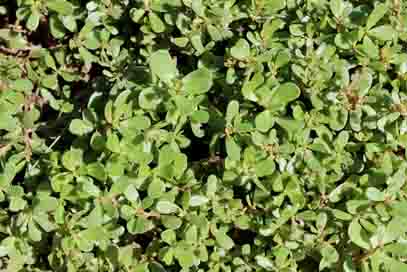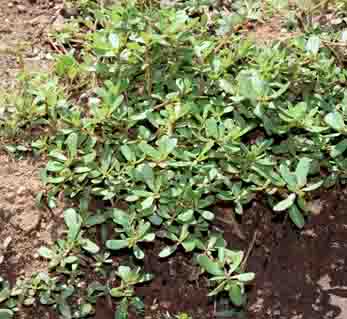 |
 |
Food:
"Presumably, the seeds were then mixed with those from plants such as sunflowers or Indian ricegrass for a mush or ground into flour for breads.
The succulent stems and leaves, high in vitamins A and C, may be boiled (then sometimes fried) and eaten alone. They're also mixed with peas or beans or added to a stew." (Dunmire and Tierney 179)
"May be used raw or cooked. Somewhat sour tasting when young. Good as a soup thickener, marinade, steamed, pickled, in casseroles, and fresh on sandwiches. The tiny seeds are edible and may be roasted, ground into flour, or sprouted." (Seebeck 71)
"Purslane can be used raw, cooked, frozen or pickled. It should always be washed thoroughly, for it is apt to be gritty. The tender tips make a very pleasant salad, either alone or in combination with other salad plants. Purslane is neither pungent nor bitter, it has a mild acid taste and a fatty or mucilaginous quality which most people like, but a few find it objectionable.
It is this mucilaginous characteristic, which makes purslane a valuable addition to soups and stews, serving, like okra or the Creole 'gumbo file,' to give these dishes a desirable consistency.
Purslane is probably eaten more often as a plain boiled green than in any other way. The new tips, washed and then boiled for 10 minutes and seasoned with butter and salt, make a very acceptable cooked vegetable.
An even better way to cook is to cut several slices of bacon in small pieces and fry them in a large skillet. When the bacon is done, dump in about 1 quart of the tender tips of purslane. Stir until it is evenly coated with the bacon drippings, then cover and let it cook for 6 to 7 minutes. Season with salt and a little vinegar.
For those who object to the fattiness of purslane, a casserole dish can be made which completely masks this quality. Boil the tips 10 minutes, drain and chop fine. Stir 1 beaten egg into the purslane, then stir in as many fine bread crumbs as the mixture will dampen. Season to taste with salt and pepper, then bake in a moderate oven until the top is nicely browned.
(Using the seeds to make bread or gruel) "I spread the plants on a large plastic sheet and let them dry for 2 weeks. Then I beat them to loosen the seed, put them through a coarse sieve to remove the big trash and winnowed out the small stuff. I had left about 3 cups of tiny black seed. These were ground in a hand grist mill, mixed half and half with wheat flour and made into sone dark but good 'buckwheat' cakes. Eaten hot with butter and homemade maple sirup they were pronounced delicious." (Gibbons Stalking 180-1)
Recipe 1: Raw Purslane Salad
"Chop 1 small red onion, 1 cup purslane leaves and stems, 1 peeled cucumber, and 2 large garden-fresh tomatoes. Combine in a bowl; toss with 1 tablespoon each olive oil and rice vinegar. Add fresh-ground black pepper and a splash of tamari; toss well. Let sit in a cool place or at room temperature for 15 to 20 minutes. Add raw sesame seeds; toss and serve.
Variation: Add 1/2 teaspoon honey to the dressing. Prepare the oil, vinegar, tamari, pepper, and honey in a separate bowl; mix well. Toss with the salad." (Morgan 168)
Recipe 2: Good Old-Fashioned Sausage, Onion, and Purslane
"Grill 4 links spicy sausage and slice into bite-size pieces. Slice and then saute 1 medium to large yellow onion in olive oil in a skillet. When onion is halfway to caramelized, add 1 cup chopped purslane. Continue to saute until almost caramelized. Toss with sausage; serve on a bed of brown rice. Garnish with garden-fresh parsley." (Morgan 169)
Medicine:
"Various Indian tribes, among them the Navajo, Acoma and Laguna, have a medicinal tradition for purslane, the latter Puebloans at one time using a tea from the vegetative parts to cure diarrhea and as an antiseptic." (Dunmire and Tierney 179)